Hot Laptops, Desktops: Impressions From Asus' 'ROG Unleashed'
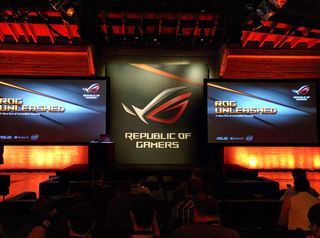
Asus wants us all to know how much it loves gamers, and at its Republic of Gamers (ROG) Unleashed event in San Francisco, the company made it clear why. Taking the stage, Kirk Skaugen, Intel's SVP of client computer, laid out the numbers: Gamers refresh their PC system every two to three years, versus six years or more for general or business users. PC gamers are also spending more on gaming software than their console counterparts. While the general PC industry may be struggling, Asus, Intel and Microsoft want us to know that PC gaming is flourishing.
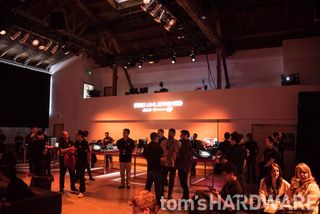
This helps explain the success of Asus' ROG program itself, a line of gamer-focused products that turned 10 this year. At ROG Unleashed, Asus revealed an array of new gaming hardware, including one of the craziest laptops we've ever seen.
Impressions
Desktops
Under the dark red lighting and pounding techno, Asus had a demo display showing off its new desktop and laptop lines. Keeping with Asus' fine tradition of baffling product names no one will ever remember, the compact desktop system is the G20CB, and the full tower comes in two flavors: the lower-end G11CD (for real?!), and the high-end G11CB.
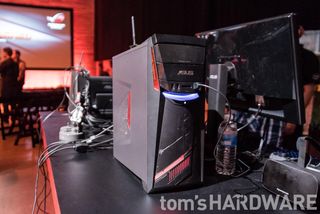
Internally, the systems have almost identical options: Up to 32 GB DDR4 2133 MHz memory, up to a 512 GB M.2 SSD, and either the AMD R9 380, or Nvidia cards from the GTX 700 and 900 series. The only place they really differ is at the super high end, where the G11CB has the option for a hybrid SSHD and a GTX 980 Ti, while strangely, the compact G20CB has no option for a 980 Ti, but can be outfitted with a GTX Titan X.
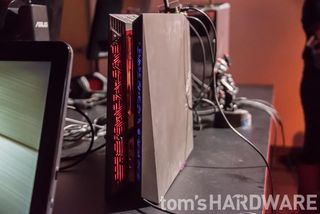
With that being the case, unless the lack of a 980 Ti is a dealbreaker for you, I can't imagine why anyone would opt for the larger, full tower G11CB. It's a large system in a fairly generic case, while the G20CB is not much bigger than an Xbox One, with an excitingly architectural style, and lighting effects that can be customized to pulse to ambient sound, which is a surprisingly cool effect.

Both of these systems will be re-released soon as "Oculus Ready editions," which simply means they'll meet the minimum system requirements to run an Oculus VR. Asus reps said they are planning to package their Oculus Ready computers with a discount voucher for the headset, likely $100 off.
Stay on the Cutting Edge
Join the experts who read Tom's Hardware for the inside track on enthusiast PC tech news — and have for over 25 years. We'll send breaking news and in-depth reviews of CPUs, GPUs, AI, maker hardware and more straight to your inbox.
Laptops
Desktops are all good and fine, but clearly the point of the entire ROG Unleashed event was to show off Asus' new laptop line. There were two models on display, both massive 17.3" affairs, weighing nearly 10 lbs, and clearly designed more for high performance than portability.
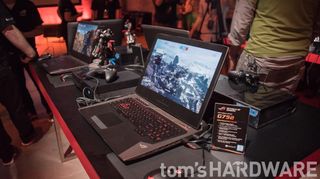
The G752 is the more normal of the two, but it's still a unique beast in its own right. The G752 has a vapor-chamber cooling design, a common cooling technology on desktop systems, but unique in a laptop. The system uses water to channel heat away from the hot components to a central radiator. Essentially, the heat of the CPU or GPU vaporizes the water on contact. The vapor is then channeled to the radiator, where it cools, condenses, and recirculates to the hot chips. The G752 uses two large radiators with blower fans to keep the system running, giving the back end of the laptop something of a hot rod effect.

Other than this innovative cooling system, the G752 is a fairly standard, high-end gaming laptop. It comes with options of Intel Skylake i7 chips (up to an unlocked i7-6820HK), a GeForce GTX 980m with either 4 or 8 GB GDD5, and various SSD / HD combos, up to a 512 GB SSD with a 1 TB HDD. It can also be equipped with a truly ludicrous 64 GB of DDR4 (more than the new desktops, it must be noted).
One nice feature is that all models of the G752 come equipped with a USB Type-C port. This particular port can be used either as a Thunderbolt 3 connection or 10 Gbps USB 3.1 port. It can also deliver up to 15 watts of power to a connected device. The 1080p screen looked as good as most Asus monitors do, with great color and contrast.
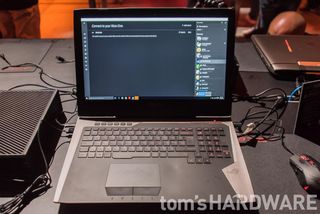
The G752 starts at $1,999, but if you want those high end specs, be prepared to shell out $3,499.
Now for the real showstopper, the Asus GX700. This laptop is a strange device, somewhere between totally ludicrous and just darn cool. Its specs are almost the same as the G752, with a few key differences. First off, it can be outfitted with two 512 GB SSDs using PCIe x4, it adds a second USB Type-C USB 3.1 10 Gbps port, and it has a full, desktop-grade GeForce GTX 980. It powers that massive graphics card with a one of a kind dock that not only delivers 330 W of power, but also hooks the laptop into a closed loop liquid cooling system.
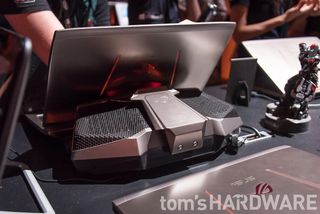
Outside of the dock, the GX700 shifts its graphics capabilities down to be closer to a GTX 980m, and it uses a 180 W power adapter to control heat. (Interestingly, the massive cooling fans on the G752 means it operates on a 220-Watt power adapter, suggesting that the laptop by itself will be more powerful than the GX700 outside of its dock.)
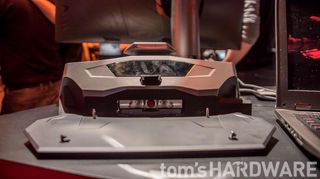

The computer snaps into the dock with a release on the top, and when it's hooked in, not only does it receive power, but four, no-drip nozzles latch onto the back of the machine, and connect it to the liquid cooling system and massive radiators built into the top of the dock. Disconnecting only takes seconds, and interestingly, the GX700 doesn't flush the coolant, (which is not water), back into the dock; its internal heat pipes stay filled with liquid. An Asus rep admitted that there can be some small coolant loss when the laptop is disconnected, but said they guarantee the system for at least two years, though after that you may need to get the dock serviced and recharged.

The display models we saw were all using 1080p screens, although a 4K option is supposed to be forthcoming. One rep said they kept with 1080p because they were worried that 4K would degrade the user experience, leading me to think that there are still some aspects of drivers or power management that need to be sorted out.
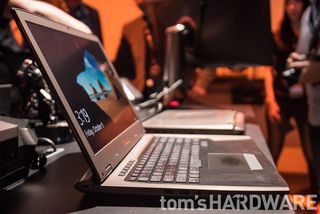
Overall I was impressed with these new laptops. They are massive, weighty powerhouses, but with beautiful screens, and surprisingly good keyboards. The keys were nicely clicky, with a good travel distance, and sufficient feedback. The machines feel fairly solid, challenging for devices this big, though they creaked and flexed a little more than I'd like.
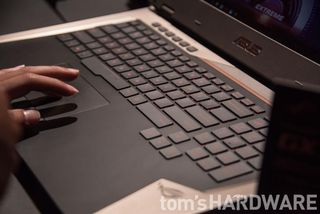
That said, there are a few aspects of the designs that I wish Asus had improved. Maybe we've just been spoiled by sleek, well-designed laptops from Dell, Lenovo and Apple, but I wish there was a little more finesse to the build of these behemoths.
For example, although the displays are beautiful, and 17.3 inches is a significant screen size on a portable computer, they're surrounded by huge bezels. Some quick Pythagorean math confirms that these machines are actually more than 21 inches corner to corner. It just feels like wasted space, and it gives them a little bit of a Laptop-From-The-90's vibe when opened.
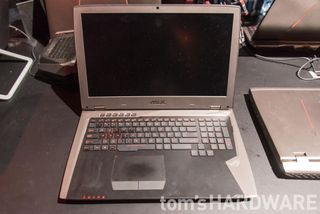
On both models, the radiator assembly at the back also sticks out a fair amount past the screen hinge. These aren't fatal flaws, and clearly if you want to buy one of these machines you likely care more about performance than design, but for more than $3,000 of machine, it would be nice if it came in a more attractive package.
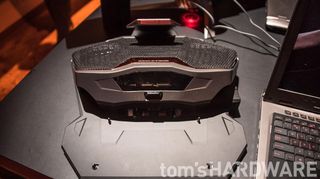
Check out the rest of our coverage of ROG unleashed.
Follow us @tomshardware, on Facebook and on Google+.
-
TechyInAZ Happy Birthday ROG. :)Reply
That's interesting that there is a little bit of coolant loss when disconnecting that radiator, I wonder if you can manually refill it instead of taking it to asus? -
Mac266 I never did like Asus's laptop design, and that's considering that if I'm a fan of anything, it's Asus. Each to his own I guess.Reply
